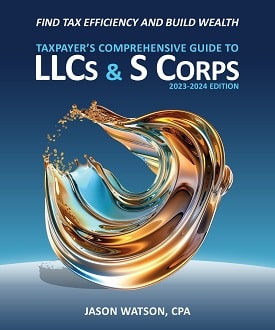You Own the Automobile, Get Reimbursed By The Mile
By Jason Watson, CPA
Posted Saturday, November 4, 2023
This might be the best option, especially if Section 179 depreciation is not going to benefit you much and/or you use the automobile personally more than you use it professionally. As the owner of the automobile, you would submit expense reports in the form of mileage logs. If you are a smart automobile owner, you would also use a smartphone app to keep track of your miles for you. Keep in mind that the IRS wants corroborating evidence to support your mileage logs, so keep those Jiffy Lube receipts or other service records showing odometer readings near the beginning and end of the year (so extrapolation can occur). Just whippin’ out a pretty color-coded spreadsheet during an IRS examination is not enough.
The business would reimburse you according to your mileage log submission. This can be a great option for a lot of reasons. First, you are reducing the net income of your business, and if you are an S Corp the lower business income could decrease the amount of reasonable salary you must take as a shareholder. Second, most automobiles generally operate for less than the federal mileage rate.
Let’s look at some numbers-
| Business Miles | 12,000 |
| Miles Per Gallon (MPG) | 25 |
| Gallon of Gas | $4.50 |
| Cost of Gas | 2,160 |
| Maintenance, Biz Portion | 3,000 |
| Total Cost | 5,160 |
| Reimbursement at $0.655 (for the 2023 tax year) | 7,860 |
| Difference | 2,700 |
As such, you just took home $2,700 tax-free. All legit. All legal. AAA might consider these operating costs to be too low, but then again this would be representative of an older or thrifty automobile. Why is that?
For the 2023 tax year, the IRS designated $0.28 of the $0.655 standard mileage rate to be depreciation of your automobile (almost half) according to IRS Notice 2022-03. Therefore, if you have a $5,000 POS which will be worth $5,000 ten years from now, you are getting reimbursed for depreciation that never happens. Cool! 10,000 miles would be $2,800 in your pocket (but you will reduce your basis in the automobile from $5,000 to $2,200).
Let’s not forget that you took money out of the business tax-free, and you reduced your business’s overall taxable income through legitimate small business tax deductions. Therefore, if we are using net business income after expenses as one of the proxies for determining a reasonable S corporation salary, that salary starts off at a lower number and subsequently reduces Social Security and Medicare taxes (among others). Win win!
Time to pump the brakes a bit. There is some confusion out there about getting reimbursed for actual expenses. For example, a business owner will own the automobile personally but also wants to get reimbursed for actual expenses. This same business owner will use the business credit card for gas and oil changes. This is bad. If you want to get reimbursed for actual expenses, it must be a pro-rated amount. If you drive 18,000 miles and 12,000 are business miles, then the business should only reimburse 75% of all actual expenses.
If you have leased your automobile and you use the standard mileage rate for reimbursement, you must continue with that method for the entire lease term.
Your business must have an Accountable Plan to take advantage of the You Own the Automobile, Get Reimbursed scenario. As a general rule, any payment of an allowance or reimbursement of business expenses for which the employee does not provide an adequate accounting (i.e., substantiation with receipts or other records) is considered to have been provided under a non-Accountable Plan and is required to be treated as taxable wages for purposes of federal, state, and local (if applicable) income tax withholding, Social Security and Medicare taxes, and Federal and state unemployment taxes. Yuck!
As a reminder, please please please use your personal funds at the gas station and service center. If you want to be reimbursed for mileage, the business will absolutely pay for nothing except the reimbursement itself. You can certainly have the business pay for all automobile expenses, but then that becomes a business owned vehicle situation described above.
Wanna Talk About Your Small Business?
Please use the form below to tell us a little about yourself, and what you have going on with your small business or 1099 contractor gig. WCG CPAs & Advisors are small business CPAs, tax professionals and consultants, and we look forward to talking to you!




